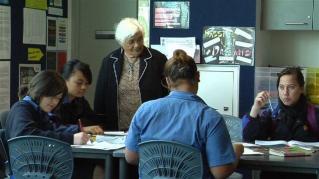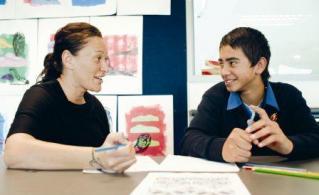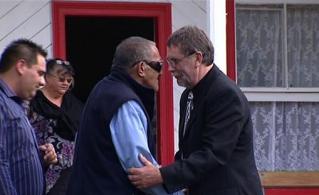Section navigation
The eleven clips featuring Taihape Area School show the positive impact of change (led by the principal) on the school, as a result of:
- engaging Māori students
- establishing school-community links
- recognizing the relationship between whānau involvement and student achievement
- making structural changes; for example, timetabling, option lines, lesson formats
- setting goals and celebrating success
- acknowledging the benefits of change in terms of attitudes, leadership, relationships, and te reo Māori me ōna tikanga
- realising that change is ongoing
- changing teaching methods (from being content focused to being learner/learning focused)
- creating genuine partnerships with whānau, hapū, iwi and Māori
- recognising the need for sustainability planning
- demonstrating strong leadership.
Questions / Things to think about / Activities
1. What would ‘engagement’ look like in our classrooms? This could include valuing ‘ako’ and problem-solving together; negotiating the learning contexts and inquiry questions; skilled teacher questioning to stimulate critical thinking; integration of local knowledge and context; co-operative learning strategies; and the sharing of assessment information with students and whānau, leading to feed forward and the co-construction of new goals.
2. How is our school meeting the Ministry requirements (NZC p 37) to:
- determine the values and expectations of our community
- consult with our Māori community, to develop and make plans and targets for improving the achievement of our Māori students
- give effect to the national curriculum in ways that best address the particular needs, interests and circumstances of our students and our community?
3. Biddulph et al (2003) report that it is sustained parental involvement (focused on learning activities/tasks) that improves student achievement. What is happening in our school to ensure real and lasting change?
4. The BES on school leadership and student outcomes (2009:35) suggests that pedagogical leadership can make a difference to student achievement. Such leadership is characterised by:
- the establishment of clear educational goals
- the planning of the curriculum
- the evaluation of teachers and teaching.
To what extent is our leadership team having a positive impact on Māori student outcomes? Are there any leadership issues in our school that may be hindering Māori student engagement and achievement?
5. What evidence is there that shows what works for Māori students, in terms of school structures and transitions? (Pages 30-31 in Key evidence: Ka Hikitia may be helpful.) How could we apply this evidence in our school?
6. How can our school demonstrate to whānau a genuine willingness to establish an equal partnership that values the respective strengths of each partner, while working together to achieve shared goals?
What are some innovative ways that we could share with Māori whānau the successes of their tamariki to ensure that success is celebrated, and that success leads to success?
Filed under: Productive partnerships | Identity Language and Culture | Effective leaders





